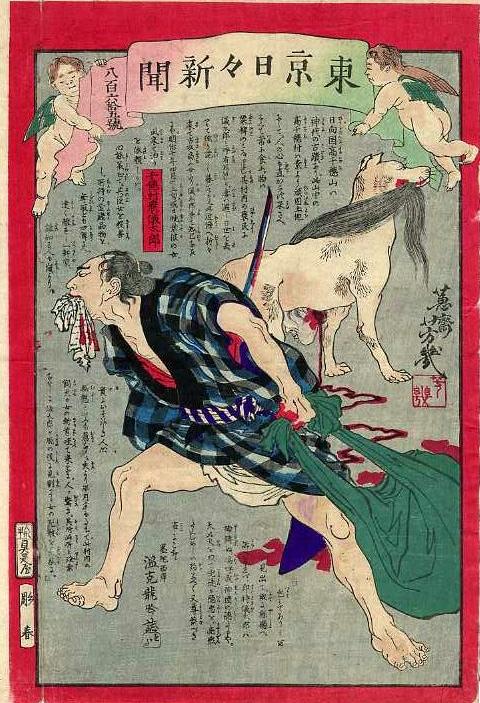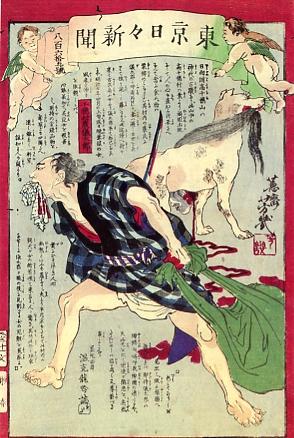Tokyo nichinichi shinbun Story translationTakachihoyama, in the province of Hyuga, is a vestige of the age of the gods. Takachiho village, in this mountain (yama), consists of land that has never been opened (has always been hard) (motoyori ganko / hirakenu), and so the hearts of the people are also not straight (naokarazu). It is said there is no rice, and that people always eat only awa [millet] and hie [millet]. Among the farmers in this village was a man called Gitaro. His wife had departed from this world some days past, and he lived a solitary and lonely life. And there was a woman who sometimes came to the area and sold old clothing. Gitaro had at some time become an acquaintance. Around the beginning of the fourth month of the seventh year of Meiji [April 1874], one evening the woman suddenly came and asked if she could stay. He cordially accepted. And that night he cut and killed her. He took the money (kinsen, gold and copper/iron coins) and things in her possession. For his was a lone house (ikken'ya), far from any neighbor, and there was no one to know, owing to the severe mountain climate (tare shiru hito mo arashi yori). People's hearts, truely frightening, are shameless (muzan) [cruel] but even more they are foolish (oroka) [ignorant]. Over half a month passed since then. Someone's dog in the village came with the severed head of a woman in its mouth. People were startled. They searched here and there and found that Gitaro had wrapped the corpse of an unfamiliar woman in a straw mat behind his stable. They immediately reported this to the prefectural hall. Gitaro was straightaway arrested. Ah, the moral powers of our land of the gods. That Heaven used a dog to reveal a bad man's hidden evil is something to fear and revere. West bank of Sumida Onkokudo Ryugin (Okada) [Translated by Mark Schreiber and William Wetherall] Commentary (Andon 80)The cartouche identifies the man as "Farmer Gitarō of Takachiho village". The nishikie version frames the story very differently, to accommodate both some wordplay and the conclusion. Unlike the newspaper article, the nishikie story calls Takachiho the "vestige of the age of the gods" -- telling those who may have forgotten, or never learned, that Takachiho was the place where the Sun Goddess Amaterasu arrived and created the Yamato nation, according to Japan's oldest legends. This laid the foundation for the didactic observation at the end -- typical of nishikie stories, but not of newspaper articles. The ending appears to allude to a well-known line from the Analects (C. Lúnyŭ, J. Rongo), which many people would have studied when learning to read. "The Master [Confucius] said, The virtues [moral powers] of the middle way [moderation] indeed extend everywhere." Onkokudō just substituted "land of the gods" for "middle way" -- and replaced "extend everywhere" by a concrete example of Heaven's omnipresence. Narrative style of nishikie storiesSome news nishikie stories are written in segments of one or more couplets of 7/5 or so morae -- although one would never know this just from looking at the text. This, too, underscores the oral foundation of written narratives. The text of this story is separated by 26 periods into 27 segments, many of which are phrases rather than sentences. The following 5 segments consist of 7 couplets.
There is some wordplay in the narrative, such as "arashi" in the last segment of the above passage. It is written with a kanji meaning "windy and stormy mountainous climate" and furigana reading "arashi". On the surface "arashi yori" means "due to the severe mountainous conditions" and explains why Gitarō was able to do what he did. But anyone who heard or read "tare shiru hito mo" (someone who knew) would expect "nashi" or "araji" (does not exist) to follow. As distinctions like "shi" and "ji" were often not marked in writing, readers were accustomed to recognizing intended readings from context, and listeners too would readily have caught such a pun. [Commentary from Wetherall and Schreiber 2006 in Andon 80] Original newspaper storyThe newspaper account on which the nishikie story was based was told very differently. The following transltion endeavors to preserve its structural features.
|
There are no full stops, commas or paragraph breaks in the original. The full stops in the translation correspond to breaks marked in the original by terminal conjugations.
The aims and styles of the introduction to Takachiho and the account of the murder are different. The introduction, in a series of short statements, describes the people of Takachiho as formed by their harsh isolation from the benefits of social organization made possible by good government. As we shall see in the next story, a similar standard of geographical determinism was used to judge some Taiwanese.
The description of Hyūga as "now within the jurisdiction of Miyazaki prefecture" reflects the fact that the Miyazaki prefecture was created just the year before -- but not for long. In 1871, when domains ruled by samurai clans were nationalised as semi-autonomous prefectures under appointed governors, Hyūga became Mimitsu and Miyakonojō prefectures. These were combined into Miyazaki prefecture in 1873. Miyazaki was merged into Kagoshima prefecture in 1876 and again became a prefecture in 1883. These changes reflect the instability in local politics that precipitated the Seinan War of 1877. Some of the fiercest battles of the war were fought around Takachiho, which sided with Saigō Takamori.
The story of the murder is told in three long objective breaths without moralizing. Today a crime reporter would begin with time, place, and discovery of the body, then reveal the background and investigation, more in the manner of an Agatha Christie mystery. This story, however, is told in real time, more like a Lieutenant Columbo drama in which we watch a crime develop from its motivation to commission, then segue to the finding of the body, investigation, and arrest.
[Translation by William Wetherall, and commentary, from Wetherall and Schreiber 2006 in Andon 80]

